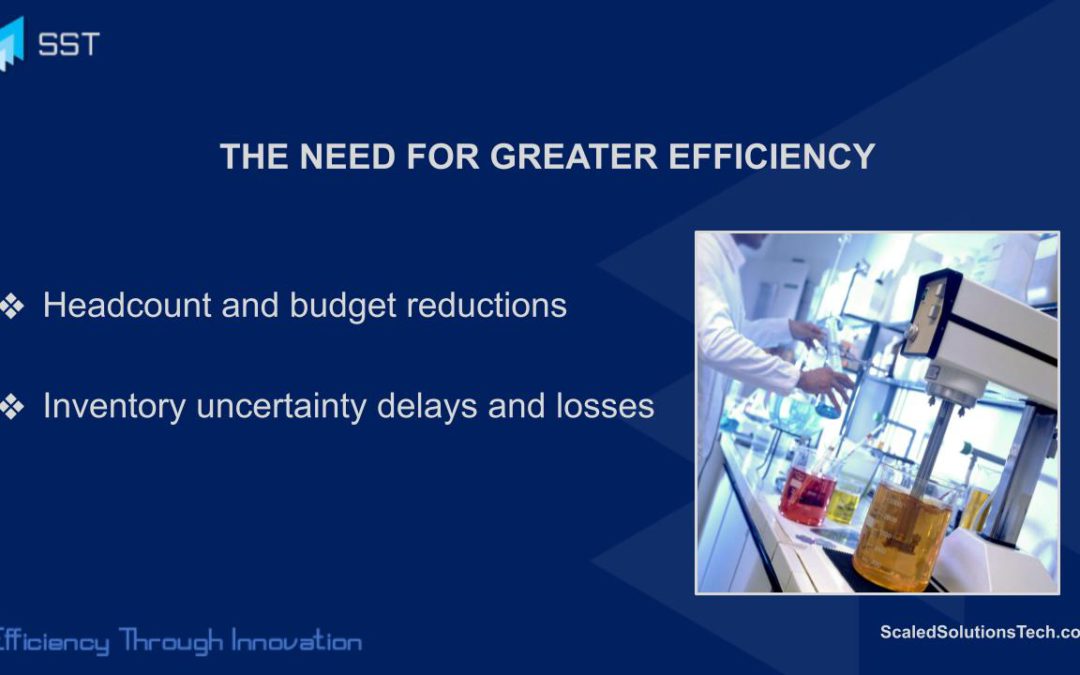Introduction
Laboratories have been hard hit by recent challenges in the wake of the COVID-19 pandemic. 1245 Some laboratory resets may take up to a year’s time. 7
Even as laboratories in some places reopen, there is a new reality of COVID-19 social distancing expectations and guidelines, 89 which could very soon become requirements or subject laboratories to civil liability.10 Laboratories will be forced to implement new procedures and take time-consuming measures to protect their researchers and employees. Costs to re-set after pandemic closures will eat into laboratory budgets. There will be less personnel, less funding, and increased tasks and costs. In this new type of environment, efficiency and cost reduction will be paramount.
However, in every crisis new opportunities arise, and the new reality of leaner and more efficient laboratories creates an incentive to move towards an automated system of inventory management. An automated system will free-up valuable personnel time and streamline processes, which will become even more valuable with the need for greater efficiency. Significant human error will be reduced, because on average, “people make an error in one out of every 300 characters they write, resulting in an average of 18 mistakes per hour.” 11
The future of laboratory inventory management lies in automated systems. A critical yet currently lacking function of automated systems is the ability to track reagents and substances that are gradually depleted as they are used. Tracking partially used reagents will allow for laboratories to buy and store only what is necessary to have on hand, while being able to timely re-order reagent supplies and redirect personnel time back to core tasks.
The Problem of Overstocking
Cost
Overstocking is a problem primarily defined in terms of costs – “Between 15 and 45 percent of a clinical laboratory’s operating budget is spent on supplies.” 12 Similar numbers can be projected to other types of laboratories. Any amount of a chemical reagent that is purchased and unused represents wasted funds, the equivalent of lighting hundred-dollar bills on the Bunsen burner. In addition to the lost opportunity by overstocking chemicals that are eventually only disposed of, overstocking causes further expense because “[o]verstocking chemicals eventually results in expensive large-scale lab clean-outs.” 13 Overstocked chemicals sitting on shelves are also subject to becoming chemical “unknowns” because chemical erosion or simply age may obscure container labels. Unidentifiable reagents must undergo analytical testing for safe disposal, “which can more than quadruple disposal costs.” 14
Safety
The disposal of old and expired reagents that were overstocked is an added and unnecessary safety risk. Despite rigorous safety procedures and standard operating procedures (“SOPS”), laboratory accidents happen1516, sometimes with deadly consequences.17 Colloquially, “every well-appointed chemistry lab is full of death in screw-capped bottles.”18 These accidents occur under the best of circumstances, but disposal of overstocked reagents carries a heightened set of risks. First, overstocked reagents are generally marked for disposal because they have expired and are likely to be unstable. Second, many chemical reagents will need to go through a quenching procedure in order to be disposed safely. While quenching in a laboratory is, at times, necessary, it can be a dangerous procedure. 19 Third, disposal occurs in conjunction with an annual or semi-annual large scale laboratory clean out. Laboratory clean outs involve the entire staff of a laboratory and can lead to inexperienced technicians or students taking on unsuitable tasks that increase the level of danger.
Environmental Waste
Finally, reagents that are overstocked, unused, and disposed of when expired generate environmental chemical waste. A significant amount of laboratory waste is generated by the expiration of unused chemicals in overstocked reagent bottles. These wasted chemicals typically constitute 40% or more of the hazardous waste stream generated.20 American Chemical Society 2002) The very act of discarding reagents contributes to environmental pollution.
Personnel Costs in a Manual System
Current laboratory practices require multiple manual tasks that require a significant investment of personnel time to complete. Personnel must do a physical count and determine what needs to be ordered. Manual systems may include one or more notebooks or whiteboards where items for ordering are hastily written down. Such a system is inefficient and prone to error and at times personnel do not even adhere to the system.
Before beginning a synthesis, a scientist will have to visually inspect storage to determine whether the needed materials are present. If a needed reagent is not in storage, the scientist will seek out other personnel who may have the needed inventory, or send out an “email blast” to see if the reagent is on site. If the needed reagent cannot be found, it must be ordered, and the synthesis put on hold until the needed reagent arrives. If, on the other hand, the needed reagents are present in storage, the scientist may feel compelled to physically move the reagents to their personal workspace, or otherwise attempt to mark and reserve the reagents for intended use.
None of these inventory lookup tasks should be necessary for performing chemical synthesis and core research. Even where a laboratory is large enough to have dedicated inventory managers, there is often still an unnecessary amount of manual data entry and an added layer of complexity from manual data management.
Existing Inventory Software Systems Are Incomplete
Existing software inventory systems are incomplete because they are not fully reliable, or do not provide all of the information needed to operate efficiently. When a scientist relies on software that indicates a particular reagent is in storage, yet finds that someone else used up and failed to remove the spent reagent from the software system, that will be the last time that scientist relies on the system. Afterwards, the scientist feels compelled to physically verify that needed reagents are in stock, thereby undermining the purpose of having inventory software which is to save personnel time and frustration.
A complete inventory system must be able to tell a scientist both what reagents are in storage, and how much remains in a particular storage container in order to eliminate the need for visual checks and inspections. A system that is able to track reagent amounts as they are depleted can assist scientists in planning experiments that may require multiple syntheses using a single lot. Purchase date, use dates, and expiration information will prevent the waste of unused reagents. A reservation system will allow for effective planning. Finally, alerts based on remaining reagent stock can be used in either automatic or alert-based ordering systems.
Conclusion
All existing systems require human inputs. Existing systems require diligent labeling and relabeling practices. Analyzing unknown chemicals for safe waste disposal is cost prohibitive. The cumulative time of personnel in a laboratory visually inspecting reagent stock or seeking missing reagents from colleagues can easily add up to hours a week per person. Costs, in terms of time, money, and waste, will be unsustainable in the near future as efficiency and streamlining becomes an overriding concern in laboratory management. Laboratories that do not adopt fully automated systems will be at a significant disadvantage. By contrast, laboratories that adopt a fully automated inventory system, which can track reagents as they are depleted, forecast use, and assist in reordering, will realize operational efficiency gains that will propel them to the forefront of innovative research.
Notes
- Covid-19 has shuttered scientific labs. It could put a generation of researchers at risk, Chen, Justin, May 4, 2020, STAT. https://www.statnews.com/2020/05/04/coronavirus-lab-shutdowns-impact-on-scientists-research-delays/.
- The COVID-19 pandemic and the research lab, Beck, Dani, April 30, 2020, Neuro Central. https://www.neuro-central.com/the-covid-19-pandemic-and-the-research-lab/
- Updated: Labs go quiet as researchers brace for long-term coronavirus disruptions, Servick, Kelly, Adrian Cho, Giorgia Guglielmi, Gretchen Vogel, Jennifer Couzin-Frankel, March 16, 2020. https://www.sciencemag.org/news/2020/03/updated-labs-go-quiet-researchers-brace-long-term-coronavirus-disruptions[/ref] While certain activities may have been moved to home offices, other research projects, dependent on an in-person presence in the laboratory, had to be wholly shut down during COVID-19 closures. 3Covid-19 has shuttered scientific labs. It could put a generation of researchers at risk, Chen, Justin, May 4, 2020, STAT. https://www.statnews.com/2020/05/04/coronavirus-lab-shutdowns-impact-on-scientists-research-delays/.
- Updated: Labs go quiet as researchers brace for long-term coronavirus disruptions, Servick, Kelly, Adrian Cho, Giorgia Guglielmi, Gretchen Vogel, Jennifer Couzin-Frankel, March 16, 2020. https://www.sciencemag.org/news/2020/03/updated-labs-go-quiet-researchers-brace-long-term-coronavirus-disruptions
- Covid-19 has shuttered scientific labs. It could put a generation of researchers at risk, Chen, Justin, May 4, 2020, STAT. https://www.statnews.com/2020/05/04/coronavirus-lab-shutdowns-impact-on-scientists-research-delays/.[/efn_note]6Updated: Labs go quiet as researchers brace for long-term coronavirus disruptions, Servick, Kelly, Adrian Cho, Giorgia Guglielmi, Gretchen Vogel, Jennifer Couzin-Frankel, March 16, 2020. https://www.sciencemag.org/news/2020/03/updated-labs-go-quiet-researchers-brace-long-term-coronavirus-disruptions
- Interim Guidance for Businesses and Employers Responding to Coronavirus Disease 2019 (COVID-19), May 2020, Centers for Disease Control, May 6, 2020https://www.cdc.gov/coronavirus/2019-ncov/community/guidance-business-response.html
- Guidance on Preparing Workplaces for COVID-19, Occupational Safety and Health Administration https://www.osha.gov/Publications/OSHA3990.pdf
- Sued Over Covid-19, Companies Scramble for Federal Court Shelter, Hussein, Fatima, Bloomberg July 20, 2020 https://news.bloomberglaw.com/daily-labor-report/sued-over-covid-19-companies-scramble-for-federal-court-shelter
- The End of the Error – How Barcode Systems Are Improving Efficiency in Labs, Yemm, Steve, May 17, 2019
- Supply Chain Management in the Clinical Laboratory, Thomas McHugh, Clinical Leadership & Management Review, Volume 20, Issue 1 https://covelab.com/CLMA_jan_feb06.pdf
- Department Of Chemistry and Chemical Biology, Harvard University https://chemistry.harvard.edu/pages/chemical-safety
- Department Of Chemistry and Chemical Biology, Harvard University https://chemistry.harvard.edu/pages/chemical-safety
- Lab Safety & Chemical Hygiene Program, Laboratory Accidents, University of California Santa Barbara https://www.ehs.ucsb.edu/labsafety/laboratory-accidents
- SOP Guidance, Stanford University https://ehs.stanford.edu/sop-guidance
- The Real Hazards of the Lab,Derek Lowe, January 23, 2009, Science Magazinehttps://blogs.sciencemag.org/pipeline/archives/2009/01/23/the_real_hazards_of_the_lab
- The Real Hazards of the Lab,Derek Lowe, January 23, 2009, Science Magazinehttps://blogs.sciencemag.org/pipeline/archives/2009/01/23/the_real_hazards_of_the_lab
- Lab Safety & Chemical Hygiene Program, Laboratory Accidents, University of California Santa Barbara https://www.ehs.ucsb.edu/labsafety/laboratory-accidents
- Less Is Better, American Chemical Society, 2002 https://www.acs.org/content/dam/acsorg/about/governance/committees/chemicalsafety/publications/less-is-better.pdf


I agree with you, Jeff, there’s no better way to track inventory than automation. It opens up the possibility of just-in-time inventory levels and prevents overstocking.
When I implemented automation at a manufacturing company, one of the most helpful results was eliminating costly errors. Removing manual input created more time for personnel to perform other duties, which improved quality output and expanded capacity. Additionally, inventory consumption was evaluated throughout the production process, so deficiencies could be addressed in real-time.
With that said, it becomes a question of why not automate?